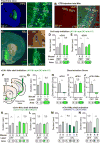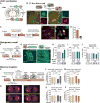Ventral CA1 neurons store social memory
- PMID: 27708103
- PMCID: PMC5493325
- DOI: 10.1126/science.aaf7003
Ventral CA1 neurons store social memory
Abstract
The medial temporal lobe, including the hippocampus, has been implicated in social memory. However, it remains unknown which parts of these brain regions and their circuits hold social memory. Here, we show that ventral hippocampal CA1 (vCA1) neurons of a mouse and their projections to nucleus accumbens (NAc) shell play a necessary and sufficient role in social memory. Both the proportion of activated vCA1 cells and the strength and stability of the responding cells are greater in response to a familiar mouse than to a previously unencountered mouse. Optogenetic reactivation of vCA1 neurons that respond to the familiar mouse enabled memory retrieval and the association of these neurons with unconditioned stimuli. Thus, vCA1 neurons and their NAc shell projections are a component of the storage site of social memory.
Copyright © 2016, American Association for the Advancement of Science.
Figures




Comment in
-
Social memory goes viral.Science. 2016 Sep 30;353(6307):1496-1497. doi: 10.1126/science.aai7788. Science. 2016. PMID: 27708089 No abstract available.
References
Publication types
MeSH terms
Grants and funding
LinkOut - more resources
Full Text Sources
Other Literature Sources
Molecular Biology Databases
Miscellaneous

